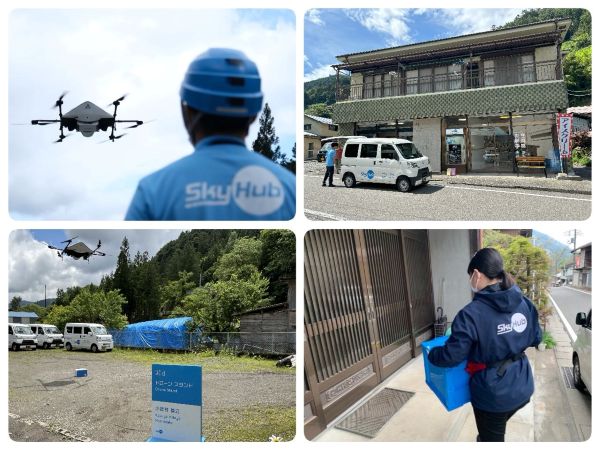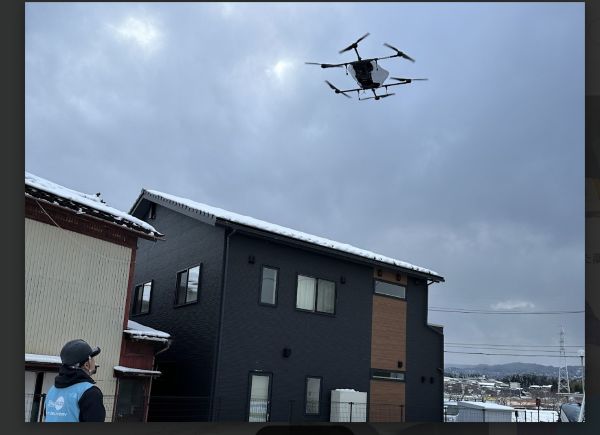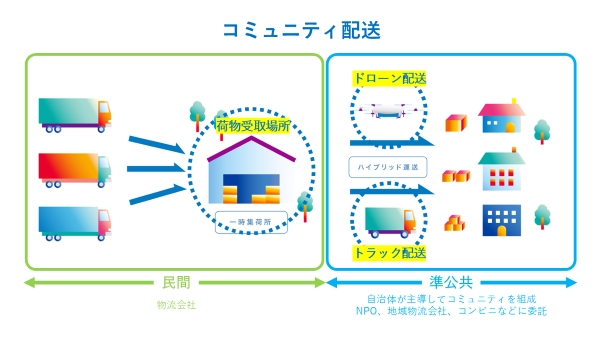
Contribute to creating prosperous local communities through the accelerated social implementation of new smart logistics.
New Smart Logistics Promotion Council was established in May 2022. Its mission is to contribute to the creation of prosperous local communities by accelerating the social implementation of new smart logistics. It does this by bringing together knowledge from private companies, primarily local governments, and fostering open information exchange, sharing experiences, and conducting discussions and research that go beyond the boundaries of the logistics industry and other sectors. The council was founded by five municipalities (*), and currently has over 60 members, including local governments, logistics and drone-related businesses, and other companies involved in new smart logistics.
The concept of "new smart logistics" aims to create a sustainable and resilient logistics infrastructure for local communities. This is achieved by optimizing the flow of goods within a region through the use of a layered approach of the latest technologies, such as:
* consolidating and streamlining goods
* creating a joint delivery system
* establishing a best mix of land and air transport
* combining cargo and passenger transport
* implementing automation.
These innovations address the various challenges that local logistics face, such as the existence of people who have difficulty shopping and accessing medical care due to an aging population and rural flight, and the need for better disaster preparedness. By optimizing the flow of goods, new smart logistics helps to save labor and reduce carbon emissions.
In recent years, the council has been actively working on various subcommittees to advance themes such as drone delivery contracts, middle-mile joint transportation, community delivery and the realization of phase-free infrastructure. It is also energetically working to make proposals to the national government and promote regulatory reforms.
(*) Kamishihoro Town (Hokkaido), Kosuge Village (Yamanashi Prefecture), Sakai Town (Ibaraki Prefecture), Tsuruga City (Fukui Prefecture), Higashikawa Town (Hokkaido)
This exhibition will feature details about "New Smart Logistics," case studies on its social implementation—including drone delivery in various municipalities—phase-free disaster logistics measures, and a display of the dedicated logistics drone.

| Address | |
|---|---|
| Phone Number | |
| URL1 | https://smartlogistics.jp/ |
| URL2 | |
| URL3 |
Product / Service

New Smart Logistics
The concept of "New Smart Logistics" is to rebuild and sustain a new local logistics infrastructure by optimizing the flow of goods within a community. This is achieved by leveraging a layered approach of the latest technologies—including cargo consolidation, joint delivery, a best mix of land and air transport, cargo-passenger mixed transport, and automation—to address various challenges that local logistics face, such as the existence of people with limited access to shopping and medical services due to an aging population and rural flight, and the need for better disaster preparedness. By optimizing the flow of goods, new smart logistics helps achieve labor savings and decarbonization.
The social implementation of "New Smart Logistics" offers more than just logistics benefits, such as promoting unmanned and zero-inventory operations and improving last-mile delivery efficiency. As the introduction of a new logistics infrastructure, it provides a solution to social issues within a region—including labor shortages due to a declining and aging population, transportation and medical problems in specific depopulated areas, and disaster and logistics vulnerability measures—which the logistics industry is currently facing with the "2024 Logistics Problem." This approach also significantly contributes to regional revitalization by enhancing resident and community satisfaction through improved convenience and quality of life.

Phase-free disaster logistics measures
"Phase-free" disaster logistics measures refer to a system where, during normal times, drones are used to transport daily necessities to establish operational procedures and collect flight data. This allows for an immediate transition to a contingency response, such as during a major earthquake when existing infrastructure is degraded, by using drones to deliver relief supplies and medical goods.
During the Noto Peninsula earthquake in January 2024, a logistics-specific drone was able to deliver medical supplies in about 10 minutes to an isolated evacuation center that would have taken Self-Defense Force personnel 2-5 hours to reach on foot. This was the first time in Japan that a drone was used to transport aid supplies during an emergency, proving the usefulness of drone delivery during a contingency and highlighting the need to build a phase-free regional "logistics" social infrastructure.
Specifically, the necessity to rapidly advance the conditions required for drone transport was recognized. This includes identifying drone takeoff and landing locations, such as local transportation hubs and isolated communities, establishing drone flight routes, and securing the understanding of local residents. These conditions can only be transitioned to and function immediately during a contingency because they have been systematically deployed and organized through normal operations—which is the very essence of phase-free disaster logistics measures.
The New Smart Logistics Promotion Council provides detailed information on real-world examples of drone-based aid transport during the January 2024 Noto Peninsula earthquake and the necessity of "phase-free" disaster logistics measures being implemented across the country.

Proposal for Community Delivery
"Community Delivery" is a model that achieves sustainable and efficient local delivery by consolidating parcels at a regional hub (depot) and carrying out the last-mile delivery using advanced technologies like drones, autonomous vehicles, and automated delivery robots, or through a "mutual assistance" framework with the cooperation of local residents. This new system increases efficiency for logistics providers—whose work is completed upon delivery to the hub—while simultaneously ensuring logistics as a vital living infrastructure for local residents.
In depopulated areas, it is becoming extremely difficult to maintain conventional logistics networks due to a declining population and a shortage of drivers. To overcome this situation, the New Smart Logistics Promotion Council has proposed introducing the "Community Delivery" model, which fuses advanced technology with the mutual assistance of local residents, and has submitted this recommendation to the national government. This model envisions a new form of local logistics that balances efficiency and sustainability, with local residents and businesses cooperating to handle last-mile delivery while leveraging new technologies.
Furthermore, in order to deploy this system nationwide, a framework for institutional design and consensus-building that takes into account the unique circumstances of each region is essential. Therefore, we are proposing the establishment of a "Local Logistics Council", where local residents, logistics providers, and municipalities can deliberate and formulate a local logistics plan together. This framework is modeled after the "Regional Public Transportation Council" system introduced in the public transportation sector, and it will serve as the foundation for realizing a community-based logistics system.
